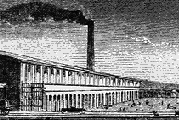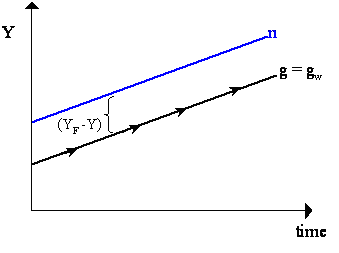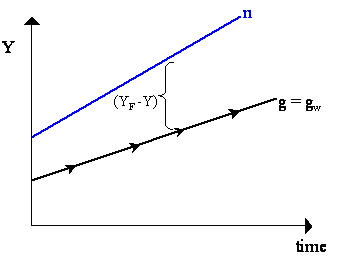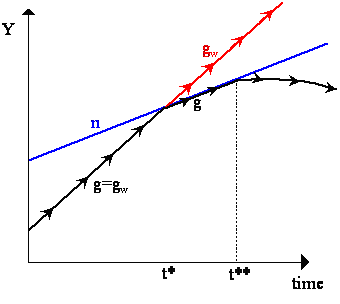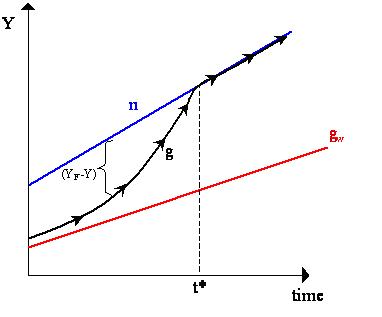|
________________________________________________________ The "macroeconomic" instability is only the first step in Harrod's argument. Harrod noted that actual growth has an upper limit -- namely, the rate of growth of primary resources like labor. He called this rate the natural rate of growth and defined it as the "maximum rate of growth allowed by the increase of population, accumulation of capital, technological improvement, and the work/leisure preference schedule, supposing that there is full employment in some sense." (Harrod, 1939: p.273). In other words, unlike Classical growth theory, Harrod assumed that labor grew at an "exogenous" rate n, i.e.
where n represents the rate of "natural" reproduction of population (technically augmented -- on which more later). We must be careful when we call the natural rate an "upper limit" to growth. The difference (g - n) is the growth rate of output per person, but it can also be considered the rate of decrease of unemployment. If g < n, then population is going faster than output growth which, bar any productivity/technical changes, implies that unemployment must be increasing over time. If g > n, then unemployment is declining. Thus, as long as there is any unemployment in the economy, g can be below or above n. But, at full employment, it is impossible that g > n. Indeed, for full employment to be maintained, it must be that g = n. So, it is only in this qualified manner that we can call n an "upper limit" of g. None of this applies to the warranted rate of growth, gw. This rate, after all, is an "abstract" concept related to "plans" alone and thereby unrelated to resource constraints. We can see the possibilities a bit more clearly in diagrammatic form. In Figure 2, we have two curves, the blue one tracing full employment output (YF), which has slope n, and a black curve denoting equilibrium output, Y (and has slope g = gw). Notice that g = gw = n, but, at all times, actual output Y is permanently below the output necessary for full employment YF. There is a permanent unemployment gap, (YF - Y), but we still have steady-state growth.
If g = gw < n, then we will have steady-state growth with an increasing unemployment gap. This is shown in Figure 3.
Figure 2 and 3 show that it is entirely possible to have g = gw £ n. But what is impossible is that we have a situation where g = gw > n permanently. Again, this is because g can only rise above n in situations of unemployment. In Figure 4, we initially have g = gw < n. But once the full employment barrier is hit at time t*, g has to conform to n. Of course, the warranted rate, gw, being abstract, does not. Thus, from t* onwards, we move into a situation where gw > g = n, which suggests an inflationary situation. But, at this point, notice that g ¹ gw anymore and so the traditional Harrodian knife-edge dynamics will also be called into play thereafter. In other words, as g < gw after t*, then we should start seeing instability. A few time periods later, (in Figure 4, after t**), the actual growth rate g will begin to fall below n as well, so g < n < gw.
The main result of Figure 4 is that the natural rate of growth, by acting as an upper bound to actual growth, can, in certain circumstances, force g to diverge from gw and thus induce macroeconomic instability. In contrast, in Figure 2 and 3, the natural rate of growth has no impact on economic growth at all. Does a depression always follow when we hit the full employment barrier? Not always. Consider Figure 5, where we have g > gw but where gw < n. In this case, the Harrodian instability dynamics imply that actual growth g will rise above gw early on and create an extended "boom" until it hits the full employment barrier. However, once it hits the full employment barrier, g will be forced to conform to n, so g = n > gw. As g > gw, there will continue to be a tendency for actual growth to rise, so there will be no tendency for actual growth to come back down. Of course, Figure 5 could mean a tendency towards inflation as the gap (YF - Y) has a tendency to go negative (over-full employment).
Comparing Figures 4 and 5, Harrod realizes that there is a curious result -- what he refers to as a dynamic "paradox of thrift". To understand this, recall that gw = s/v, so that a rise in the propensity to save, s, will increase gw, where the lower s is then the lower gw is. Now, assuming the natural rate of growth, n, in Figures 4 and 5 to be the same, then we must conclude that the gw in figure 4 is greater than the gw in Figure 5. In other words, the propensity to save is higher in Figure 4. But notice that the economy in Figure 4 has a tendency to fall into depression (i.e. after the full employment barrier is hit), while the economy in Figure 5 enjoy a sustained boom with no depressive tendencies -- after it hits the full employment barrier, it just stays there. Figures 4 and 5 also have different implications for policy. Suppose changes in the propensity to save, s, were amenable to policy. Then, in Figure 4, the top priority would be to reduce the propensity to save, thereby bringing gw down to n and thus removing the tendency to depression. In Figure 5, the best policy would be to increase the propensity to save, bringing gw up to n (= g) and thus nullifying the tendency for over-full employment. As Harrod notes: "I believe that this paradox is very near the heart of the contrast between Keynesian economics and classical economics. Saving is a virtue and beneficial so long as [gw] is below [n]. While it is disastrous to have [gw] above [n], it is not good to have it too far below, for in that case although we may have plenty of booms and a frequent tendency to approach full employment, the high employment will be of an inflationary and thereby unhealthy character. In these circumstances, saving is a virtue since, by raising [gw], it enables us to have good employment without inflation. But if [gw] is above [n] saving is a force making for depression." (Harrod, 1948: p.88-9).
|
All rights reserved, Gonçalo L. Fonseca

